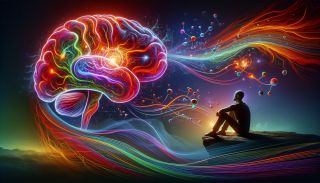Dopamine
The Truth About Dopamine and Your Brain
Myths, misconceptions and opportunities.
Posted March 21, 2024 Reviewed by Gary Drevitch
Key points
- Popular dopamine myths include that it's the "pleasure molecule."
- "Hacking," "detoxing," and "fasting" the dopamine system are poorly supported by neuroscience.
- Instead you can benefit from actions that can enhance mood, focus, energy, and general brain well-being

There’s no shortage of blogs, podcasts, and self-help books on the importance of dopamine for the brain. In fact, many portray dopamine as the secret to better motivation, sharper thinking, and lasting happiness. So how much of this is based in science? What is the real role of dopamine in the brain, and is it really the key to better brain function?
Dopamine is a neurotransmitter—a tiny chemical molecule that carries signals throughout the brain. Outside the brain, it’s involved in blood pressure, digestion, kidney function, and more. Within the brain, dopamine is synthesized from an amino acid called tyrosine. Dopamine is produced in three parts of the brain: the substantia nigra, the ventral tegmental area, and the hypothalamus. Dopamine neurons located in the ventral tegmental area (VTA) interface with parts of our brain that regulate emotions and higher-level cognition. It is involved in aspects of brain function ranging from behavior to cognition to movement, motivation, sleep, memory, learning, and punishment and reward.
The roles of dopamine in healthy and unhealthy brains
Dopamine is vital for healthy brain function. When issues arise in with dopamine balance in our brains, diseases and disorders can follow. Here are some of the most important functions of dopamine and evidence demonstrating the impact of dysfunction:
- Movement. In the part of the brain called the basal ganglia, dopamine plays a key role in muscle movement. Here, dopamine produced by the substantia nigra transfers over to a part of the basal ganglia called the putamen. This pathway is known to be disrupted in Parkinson’s disease, a condition characterized by tremor and rigidity. Damage to this system is also linked to ADHD, obsessive-compulsive disorder, Tourette syndrome, and schizophrenia.
- Motivation. The firing of dopamine neurons in the VTA is strongly linked to motivation. In addition, dopamine deficiency states are linked to higher levels of apathy. Interestingly, dopamine signals from the VTA are now understood to be influenced by immunity. Recent work finds that higher levels of inflammation in the brain may suppress dopamine release, suggesting that inflammation in the brain may decrease motivation.
- Learning and memory. Dopamine is key to the formation of memories, especially those tethered to reward and novelty. We’re also learning that this may impact multiple subtypes of memory. For example, it is linked to memory formation related to listening to music—and in a 2021 paper published in Nature Molecular Psychiatry, dopamine release was linked to stronger fear memories.
- Mood and behavioral issues. It’s been known for some time that dopamine is involved in mood and behavioral states including depression, bipolar disorder, schizophrenia, PTSD, addiction, ADHD, and others. Yet it’s important to note that this research is not always linear or clear. For example, medications that block dopamine and increase it can both be effective in depression.
Popular myths about dopamine
1. Dopamine is "good" or "bad." One of the most popular myths about dopamine concerns the idea that dopamine is either a good or a bad thing in our brains and bodies. The reality is that dopamine is a key molecule across a host of pathways, but too much or too little are both unhelpful. To this end, the idea that we should seek to massively boost dopamine levels or drop them dramatically is quite impractical and poorly backed by science. To this end, more dopamine doesn’t mean more happiness.
2. Dopamine is the “pleasure” molecule. Perhaps the most popular myth about dopamine relates to its reputation as the “pleasure molecule.” This misconception stems from older research that showed dopamine neurons activating in the context of reward, leading to the belief that dopamine was the reason we felt pleasure after engaging in a behavior like sex, drug use, gambling, or consuming certain foods. More recent research shows that dopamine has less to do with the experience of pleasure and more to do with anticipating or craving something. The technical term for dopamine’s role in reward circuits is “reward prediction error.” In essence, dopamine helps teach our brains when something is better or worse than predicted, so we can make better choices next time around.
3. You can “hack” “fast” or “detox” your brain's dopamine. Dopamine “hacking” or “fasting” have become popular concepts on wellness and productivity blogs. The basic idea is that we can easily harness our brain’s dopamine systems to make ourselves more successful, more focused, and generally better humans. Often, the concept is presented simply: By withdrawing from pleasurable activities and doing unpleasant things like taking cold showers, we can “reset” our brain’s dopamine, and in doing so reduce stress, hinder addictive tendencies, and generally improve our brain function. The issue is that there’s really no science to back the claim. The inventor of the “dopamine fast,” psychologist Cameron Sepah, has even indicated that the concept has less to do with actual brain dopamine, and more to do with a catchy framework for tackling unhealthy and impulsive behaviors.
What you really need to know about dopamine
At a very basic level, dopamine is an essential neurotransmitter that carries data between neurons. When dopamine neurons and systems are damaged, diseases like Parkinson’s can arise. While it’s less clear to what extent our actions directly impact brain dopamine levels, we know that we can positively impact the brain processes that are often discussed alongside dopamine. To this end, actions that can help enhance mood, focus, energy, and general brain well-being include:
- Prioritize regular, high-quality sleep.
- When possible, get around 30 minutes of exposure to early-morning sunlight.
- Use habit-change science to form healthier patterns of behavior.
- Eat a diet rich in a diversity of nutrient-rich foods and avoid highly-processed food.
- There is some data supporting the higher consumption of the amino acid tyrosine (which the body uses to make dopamine) for better brain function. Tyrosine is found in higher concentration in eggs, beans, nuts, soy, dairy, chicken, and beef.
- Pursue regular physical activity.
- Create checks and balances for time spent in unhealthy behavior loops (e.g., social media scrolling, online shopping, online gambling).
- Seek mental and cognitive health support from a qualified professional if needed. To find a therapist, visit the Psychology Today Therapy Directory.


